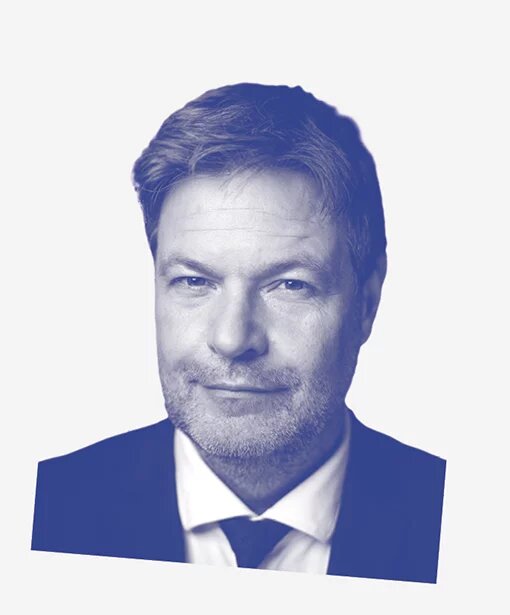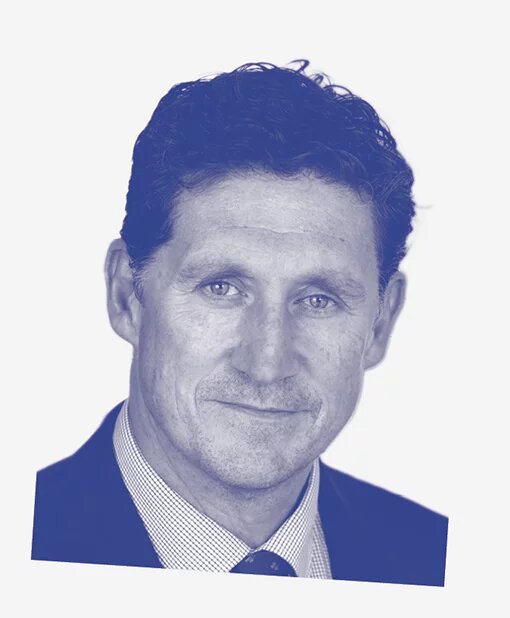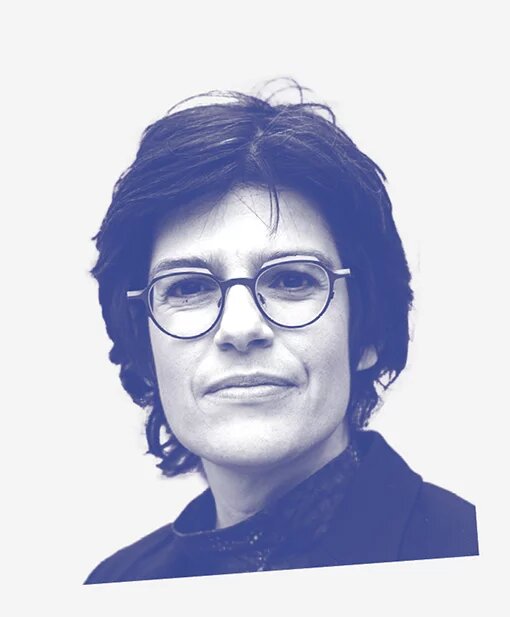Green ministers of climate and economy from Germany, Austria, Ireland, and Belgium take stock of the EGD, outlining the necessary steps toward success.
- GERMANY: «Europe’s task, Europe’s strength»
- AUSTRIA: «It’s a question of survival»
- IRELAND: «We can become the world’s first carbon-neutral economy»
- BELGIUM: «We are not yet on the right track»
«Europe’s task, Europe’s strength»
If the EU is to assume its geopolitical responsibility and hold its own in the global competition between systems, it must meet the objectives of the European Green Deal and strengthen social cohesion in Europe.
Text: Robert Habeck
For a long time, the visionary promise of peace, freedom, security, and prosperity was the magnet that drove European integration. But then, just as the EU welcomed ten new members, referendums on a European constitution failed in France and the Netherlands, breaking our trust that this narrative of progress would continue to advance in a straight line. Then came the euro crisis, Brexit, and diverging refugee policies. Climate protection and nature conservation were mostly considered antithetical to successful economic policy, especially in times of economic downturn. The European Green Deal was a courageous and necessary response to this gridlock. It was a historic step forward, spelling a concrete vision for the future: a community of highly industrialized, democratic states was to become the world’s first climate-neutral continent.
The 2015 Paris Agreement had set the framework, but it was the European Green Deal that first linked economic prosperity and value creation with climate neutrality as a key objective for humanity, with a powerful, concrete action package to achieve it. The EGD created a benchmark for all Member States, regions, and municipalities.
The EGD contains measures and laws across all economic sectors. It includes the EU’s historical Fit for 55 climate package with the European Climate Law at its core. Europe has agreed to significantly enhance and expand EU emissions trading and to adjust targets in areas that do not fall under emissions trading. The Climate Social Fund is our first joint instrument to cushion negative social effects of climate action. The Carbon Border Adjustment Mechanism (CBAM) is designed to stem carbon leakage to other locations, which would create unfair competitive conditions for our companies. Renewable energies across the EU will be doubled by 2030, energy consumption will be massively reduced, and a Nature Restoration Law will impose stricter protections for our natural environment. We have reached agreements between the Member States and the European Parliament on almost all of our dossiers, from the electricity market to the circular economy. The EGD was a good starting point for us to tackle economic, climate, and environmental policies as one coherent issue.
We must not fall behind in the competition for future technologies
But it is also true that our challenges have only grown in recent years. The Russian war of aggression against Ukraine has fundamentally changed the geopolitical situation. It has driven home the urgent need to strengthen our economic security and societal and social resilience. The climate crisis continues to advance. The US has passed an ambitious legislative package around the Inflation Reduction Act (IRA) to counter climate change with massive support for its industry while also reindustrializing the country. This is good news for the climate. Europe must take the IRA as an incentive to keep up in the race for the technologies of the future. It is the only way to preserve our prosperity and to let our citizens partake of this prosperity in the future.
This is why in the years ahead, the EGD must focus even more on a climate-neutral renewal of our European industry. For instance, green steel will likely prevail as the leading global steel technology. We must decide whether this transformation will take place here in Europe or whether we will be importing green steel from elsewhere. Industry is not just about products, however, but also about solid, future-proof jobs, our future economic model, and not least about our social fabric and sense of community. That is why I believe that Europe must remain a strong industrial location, especially for the many medium-sized companies that form the backbone of our economy.
By passing the Net Zero Industry Act, we are heading in the right direction. Key climate-neutral technologies underpin our economic security. But one thing is clear: Europe must act far more resolutely, both in terms of EU state aid law and cutting unnecessary red tape, including planning and approval processes. The EU’s next Multiannual Financial Framework will have to reflect this, since it will determine financial policy priorities of the EU well into the next decade.
Europe’s promise came back to the fore when the Covid-19 pandemic hit and certainly when Russia began to wage a war of aggression against Ukraine. Living up to its geopolitical responsibility will be a key task for the EU in the years to come. If we are to summon the necessary strength and hold our own in the global competition between systems, we must meet the objectives of the EGD. We also need to strengthen social cohesion in Europe in order to garner broad support for this transformation among our population. We must master the dramatic upheavals of our times to stay our European course of peace, freedom, social rights, security, and prosperity and to retain its appeal in the future.
Robert Habeck is Vice-Chancellor and Federal Minister for Economic Affairs and Climate Action of the Federal Republic of Germany.
«It’s a question of survival»
After scoring some initial key successes in climate policy, the European Green Deal must enter a second legislative period. It must make the EU competitive on the market for the best green products, while also ensuring social justice and prosperity.
Text: Leonore Gewessler
In 2024, the EU will set the future course in a number of areas. The parliamentary elections will decide whether we can continue on our course of transforming the continent toward climate neutrality. But the fight against global heating and environmental destruction is more than a campaign issue – it is a matter of survival.
And yet, in times of multiple geopolitical crises, it is not easy to rally people behind these goals. A global health crisis, Russia’s brutal, illegal invasion of Ukraine, and terror and war in the Middle East: All of these crises leave many people unsettled and concerned for their financial future. Political extremists are exploiting this challenging situation, stoking prejudice with lies, and attempting to derail any serious debate.
Courageous climate policy has also been a target of such attacks in recent months. Instead of conveying a message of hope and optimism, some try to spread gloom and skepticism. As a politician, my job is to counteract this: We need confidence and courage, especially in difficult times. We have to get our message out and communicate our successes. Europe is on its way to becoming the first climate-neutral continent. We can be proud of that.
Just four years ago, Commission President Ursula von der Leyen presented the EGD as a blueprint for our transition to an environmentally sustainable society. The Fit for 55 package and its new guidelines and regulations put us on the right track. The EU will reduce emissions that harm our climate by more than 55 percent by 2030. Many of the laws in the package have now been passed. This is an achievement that hardly anyone would have thought possible when the package was first presented in July 2021.
Ambitious climate policy combined with ambitious economic policy
Here in Austria, too, we have taken action to bring the EGD to life: We introduced the KlimaTicket, or climate ticket, which is valid on all public transit and costs €3 a day. With our eco-social tax reform, we introduced national CO₂ pricing, including a climate bonus for everyone, and we are converting our electricity system to run on 100 per cent green electricity by 2030. Our target is to attain climate neutrality by 2040.
Yet we must not rest on our laurels. An ambitious climate policy goes hand in hand with ambitious economic policy and social justice. The EGD must therefore enter a second legislative period. This European Green Deal 2.0 must tackle the next steps in climate action, make the EU competitive in the global contest for the greenest products, and guarantee social justice and prosperity. We must be clear that none of this will happen on its own, however. It will require determined and assertive action by climate activists and Greens.
Our common goal is a habitable planet for us and our grandchildren. A healthy climate for today and tomorrow: This is the historic mission of the Green movement, especially in this European election year 2024.
Leonore Gewessler has served as Federal Minister for Climate Action, Environment, Energy, Mobility, Innovation and Technology of the Republic of Austria since 2020. From 2014 to 2019, she was Managing Director of the environmental organization Global 2000.
«We can become the world’s first carbon-neutral economy»
The EU has both the capacity and the ambition to achieve its collective climate goals for 2030. However, we should not underestimate the scale of the challenge associated with this transition.
Text: Eamon Ryan
The launch of the European Green Deal in December 2019 reset the EU’s approach to green growth, fundamentally changing the way the EU economy operates to one where growth is decoupled from pollution and resource use, and where our natural capital is protected and developed. This is a huge project, and while we have a long way to go to our end goal, a considerable amount of progress has been made across the board already, particularly in relation to the protection of biodiversity, action on chemicals, and policies addressing pollution to air, water, and soils. The European Climate Law has set into legislation the aim for a climate-neutral EU by 2050, increasing the EU’s 2030 target to a 55 percent reduction in emissions, underpinned by the Fit for 55 program.
I am proud that with the Green Deal, the EU and its Member States have established themselves as leaders in climate action with some of the most ambitious climate targets in the world. While the framework, capacity, and ambition are there to achieve our collective climate goals for 2030, we should not underestimate the scale of the challenge associated with this transition.
Energy security is best ensured by harnessing our renewable, homegrown resources. Critical to this is the transformation of our energy sectors to clean energy across all sectors of the economy. Energy price volatility and the cost of living crisis are perhaps the key challenge to this objective. Governments across Europe are being forced to make difficult decisions on energy mix and supply. However, while this is a challenge, it is also an opportunity. The energy crisis precipitated by Russia’s invasion of Ukraine has shown that energy security is best ensured by harnessing the full potential of our renewable, homegrown resources.
The steps required for the transformation of our economies have been well established with the new Green Deal. What is essential now is that all EU Member States and institutions deliver on its ambition at speed and at scale.
The Commission is currently preparing a proposal for a union-wide climate target for 2040. This target will provide another important stepping stone between the EU’s 2030 targets and the end goal of being the first truly carbon-neutral global economy.
Eamon Ryan is the Irish Minister for Transport and the Minister for the Environment, Climate and Communications as well as Chairman of the Green Party/Comhaontas Glas of Ireland.
«We are not yet on the right track»
Solar power from the south, wind energy from the sea, and hydropower from the mountains must flow freely throughout Europe to supply energy to citizens and industry.
Text: Tinne Van der Straeten
Europe’s “man on the moon” moment: This is the image that Ursula von der Leyen, President of the European Commission, presented in December 2019 when unveiling the European Green Deal (EDG). The ambition matched the stakes: a roadmap, about 50 actions, to make Europe the first climate-neutral continent.
Amid successive crises, some European political leaders warned that legislation should not be “overloaded”; they suggested taking a break. However, the right response was not a step back but genuine progress. And progress means pushing ahead in our fight against global heating. The Green Deal has touched on numerous areas, and there is still much work to be done in terms of implementation. We cannot hit the pause button on our ambitions now.
We are not on the right track yet. Even before the end of 2023, we already knew that it would be the hottest year ever recorded since the pre-industrial era, with global heating causing suffering worldwide. The window of opportunity to keep the 1.5°C target within reach is closing rapidly.
We must act at every level of authority and work together on an effective climate policy at the EU level. The era of “every man for himself” is over. The war in Ukraine has reminded us of the urgency to break free from our dependence on fossil fuels. It has prompted almost all European countries to rethink their energy policy.
We must be able to act on taxation, end subsidies for fossil fuels, introduce a carbon price across almost the entire economy, set standards to decarbonize transportation and buildings, support the energy renovation of our homes, and implement policies that promote sustainable mobility, leaving no one behind.
Green electricity for every European family: We must deploy an integrated European electrical network
Last April, nine North Sea countries committed to making the North Sea the largest sustainable power station, multiplying our offshore electricity production by ten by 2050. With 300 GW of green electricity from the North Sea, we can provide affordable electricity to 300 million families.
Working together is necessary. For every European family to have access to green electricity, we must deploy an integrated European electrical network that allows solar electricity from the south, wind energy from the seas, and hydropower from the mountains to flow freely across Europe, providing citizens and industries with green, affordable, and competitive energy to meet their needs. This is a focal point of the agenda of the Belgian Presidency of the EU Council, which began on January 1, 2024.
Tinne Van der Straeten is Belgium’s Minister for Energy. She previously served as a member of the Federal Parliament (2007–2010, 2019–2020). She has been a board member of various organizations, such as the King Baudouin Foundation and the Center for General Welfare (CAW) in Brussels.




